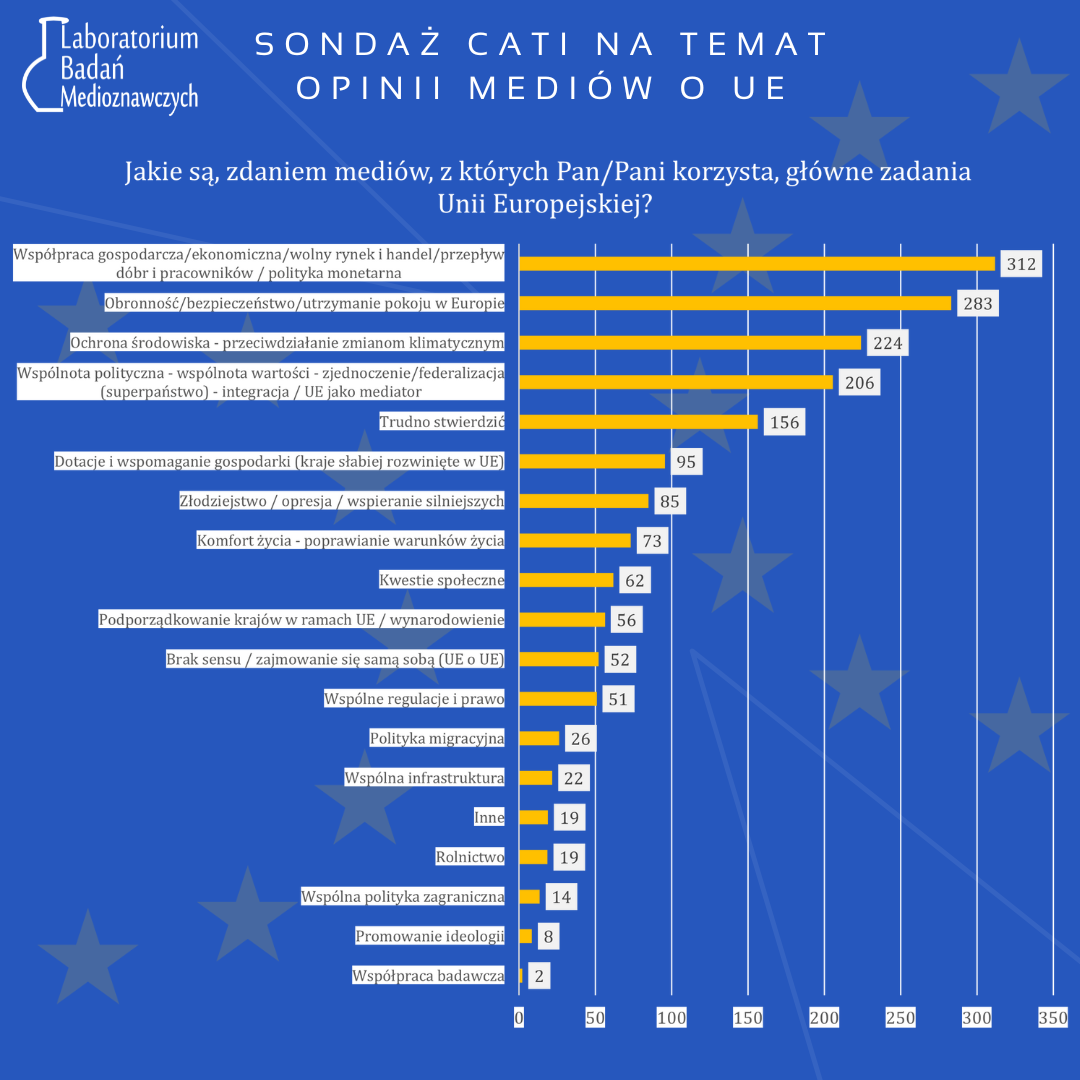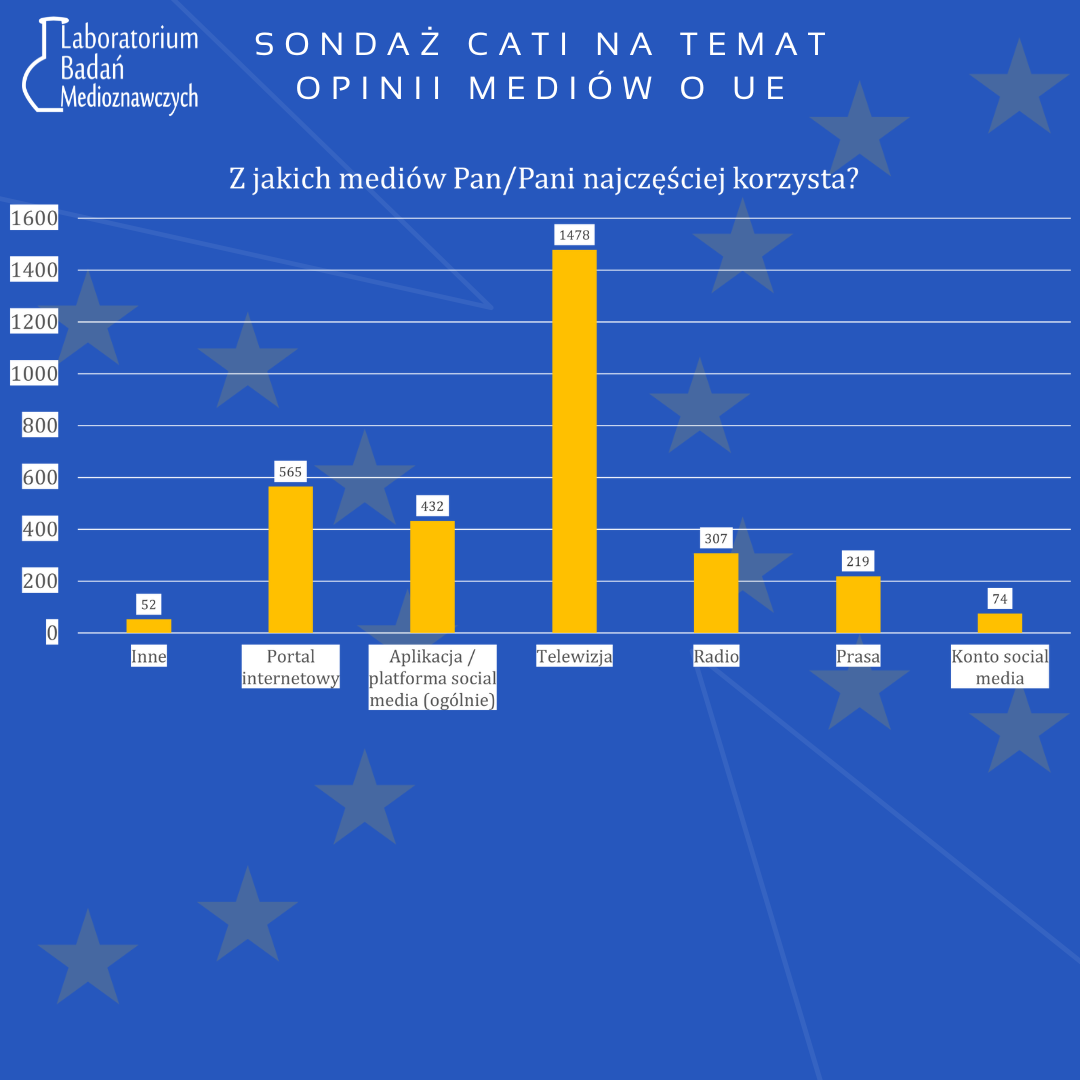 The team from the Laboratory of Media Studies at the University of Warsaw conducted a survey asking Poles about their perceptions of the media they use daily concerning the inclusion of Ukraine in the EU and which countries, according to these same media, are Poland's allies within the European Union. They also inquired about the main tasks of the European Union and which media Poles use most frequently.
The team from the Laboratory of Media Studies at the University of Warsaw conducted a survey asking Poles about their perceptions of the media they use daily concerning the inclusion of Ukraine in the EU and which countries, according to these same media, are Poland's allies within the European Union. They also inquired about the main tasks of the European Union and which media Poles use most frequently.
This year marks the 20th anniversary of Poland's accession to the European Union. To mark the occasion, the Laboratory of Media Studies at the University of Warsaw decided to conduct a CATI (computer-assisted telephone interview) survey on the topic of the EU in Polish media as perceived by Poles*. The survey was conducted from June 3 to 6, 2024, with 1219 respondents participating.
Who are our allies in the European Union? (Chart 1)
Regarding the question of who is Poland's ally in the European Union, respondents were divided. 40% indicated that, according to the media they use, Germany is the most important ally. However, almost as many respondents (36%) said that no country is our ally. The following places were taken by: France (8%), Hungary (5%), and Italy, Lithuania, the Czech Republic, and Belgium, each receiving 2%. Only one percent of respondents indicated Spain and Slovakia.
This presents a picture of the European Union not as a community of allies but as a platform for competition, a game of interests, and competition on many parallel fields. Moreover, it seems to be the result of media using, in a highly polarized discourse, primarily a conflict frame in describing relations within the European Union (confrontation, submission, or dominance). There is little about partnership, benefits, synergies, and more about threats and risks. This is, of course, largely a reflection of the rivalry between political elites at the national and European levels. In times of geopolitical turmoil, this can be worrying - notes Prof. Tomasz Gackowski, head of the Laboratory of Media Studies at UW.
Ukraine in the EU – media are in favor! (Chart 2)
It turns out that 60% of respondents believe that the media they use support Ukraine joining the European Union. Only 6% of the Polish population noticed that the media representing them say "definitely not" or "no." A quarter of respondents (26%) indicated the answer "hard to say."
This presents a picture of a pro-Ukrainian media discourse in the context of the potential expansion of the European Union to include Ukraine. This is particularly important as the accession negotiations between the European Union and Ukraine and Moldova are just beginning. At the same time, one in four respondents has difficulty determining the position on this issue in their favorite media or social media channel. This most likely means that either this position is not clear or the issue of Ukraine's accession to the EU is not particularly emphasized in the programs that the user regularly watches - emphasizes Dr. Karolina Brylska, Laboratory of Media Studies UW.
21 tasks of the European Union (Chart 3)
During the survey, respondents also answered the question of what, in their opinion, are the main tasks of the European Union according to the media they use. During the interviews, respondents freely, within an open question, pointed to the tasks of the European Union, which were then categorized into 21 categories. These data indicate how broadly the media define, in the opinion of Poles, the tasks of the European Union. Respondents could provide more than one task in their answer. Poles primarily pointed to economic cooperation, free market and trade, free movement of goods and workers, and monetary policy (the euro) - over 18% of indications. The second most noted task was defense, security, and maintaining peace in Europe (16%). The third was environmental protection - counteracting climate catastrophe (including the Green Deal) - 13%. The fourth was political unity - a community of values (logic of unification/federalization - creating a superstate), further integration, and treating Brussels as a mediator within the EU. Finally, the fifth category in our ranking was "Hard to say." This category included responses from respondents who had difficulty attributing any tasks to the European Union based on the discourse in the media they use.
It can be inferred from this that one in ten Poles - media users - does not really know what the European Union is for, what they can expect from it. After 20 years of Poland's presence in the EU, this is quite a thought-provoking observation. It is also impossible to ignore the responses (a smaller percentage of indications) that largely question the essence of the European Union - in these categories, statements such as: theft, oppression, supporting the stronger, subordinating some countries to others, denationalization, focusing on itself (the EU about the EU), or promoting ideology appeared. Summing up these indications would give a result at the level of even 20% of total indications. It seems, therefore, that these responses are an expression of Euroscepticism present in Polish society (but also in other EU countries, looking at the results of the last European Parliament elections) - concludes Prof. Anna Mierzecka, Laboratory of Media Studies UW.
Media consumption among Poles (Chart 4)
Respondents participating in the survey also indicated which media they use most frequently. The responses were varied. In traditional media, television is the dominant medium, while among new media, respondents most frequently mentioned internet portals. The next places were taken by specific channels on YouTube. For portals, the most frequently indicated were Onet.pl and Wp.pl. Interia.pl also made it to the podium (at a significant distance). Gazeta.pl and Oko.press were also mentioned. Regarding apps/social media portals – Facebook, YouTube, X (formerly Twitter), Instagram, and Tik Tok were noted. As for radio, RMF FM was dominant. The second place was taken by Tok FM, followed by the First and Second Program of Polish Radio and Antyradio. In the press category, Gazeta Wyborcza was dominant, followed by the weeklies Polityka, Newsweek, Angora, and Rzeczpospolita. In the case of social media accounts, Kanał Zero stood out.
During the survey, our respondents were asked which media they use. Importantly, it was an open-ended question where respondents could independently indicate the types of media as well as specific media brands they use to obtain current information. The vast majority of respondents (88%) provided answers by naming specific media. The next two groups of respondents specified the type of medium without specifying a media brand (6%) or specific programs or author channels on social media (5%). When classified by type of media, television clearly dominated (47% of indications), followed by internet portals (18% of indications) and specific apps and social media platforms (14%). These were primarily Facebook and Twitter/X. Other traditional media indicated by respondents played a rather complementary role to television and internet sources. Radio as a primary source of information appeared in 10% of indications, and the press in 7% of indications. Interestingly, a noticeable part of respondents indicated personalized accounts on social media linked to specific organizations or individuals as a source of information (slightly over 2% of indications).
The distribution of responses to this question indicates the still leading role of television as an information medium, with a very clear position of internet sources in second place. The specificity of responses in the survey indicates that for older audience groups, television programs are the dominant form of obtaining information, while for younger groups, information portals and social media are predominant. Radio and press serve a complementary role for both of these groups. A very interesting trend visible in the survey is also the emergence of media brands operating exclusively in social media, which build their visibility and recognition through the use of charismatic hosts' images and in-depth analytical journalism - says M.Sc. Marcin Łączyński, Laboratory of Media Studies UW.
The CATI survey (computer-assisted telephone interview) was conducted in the week preceding the European Parliament elections (June 3-6, 2024). During the survey, 1219 respondents were successfully interviewed.
The full research report will be published soon on the website of the Laboratory of Media Studies UW*.
……………………………..
The Laboratory of Media Studies at the University of Warsaw (LBM UW) is an interdisciplinary team of specialists - media scholars, linguists, psychologists, sociologists, information scientists, political scientists, and statisticians. LBM conducts research on media content and reception, including games and virtual reality.
*The results obtained in the study were subjected to weighting procedures based on demographic data on the structure of the Polish population collected by the Central Statistical Office. Weighting involves comparing the structure of the sample of people with whom we conducted a computer-assisted telephone survey (CATI), in which we learned their gender, age, education, and place of residence, to the demographic structure of adult Poles. Based on this comparison, we adjusted the results (representativeness) by assigning weights to the answers given to the questions, taking demographic data into account. This method of weighing the results, considering the differences between the sample's structure and the actual structure of the population, allowed us to bring the results closer to the actual opinions and behaviors of adult Poles regarding the subject of our study.



